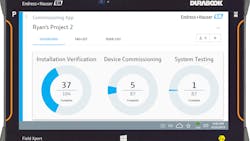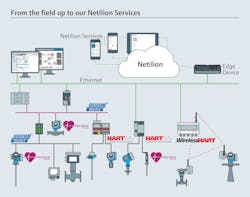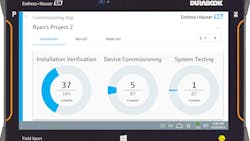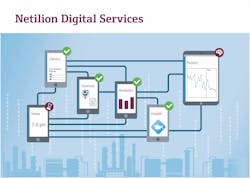Effective instrument commissioning enables seamless project startups
Over the last several decades, process instrumentation has become far more accurate and versatile, but can be more complex to configure. As a case in point, consider a basic process pressure measurement:
- A mechanical gauge had a range, a class and perhaps an accessory, but that was it.
- Early electronic transmitters (1970s) had half-a-dozen settings.
- Later electronic transmitters (1990s) added more internal processing which meant more settings.
Today’s transmitters are extremely powerful with internal electronics to process the basic reading, deliver additional variables, perform internal diagnostics, monitor other process conditions, self-calibrate, retain historical performance data, monitor power quality and more. Most recently, the growth of IIoT capabilities adds even more sophistication.
As an example, an Endress+Hauser Proline Coriolis flowmeter can detect a wide variety of process conditions beyond the normal set of variables (Table 1). Every type of transmitter can’t do every function, but a full configuration can often require verification of 100 or more settings.
Multiply this by the hundreds and potentially thousands of instruments and smart devices involved in a process unit upgrade, new process unit or a greenfield facility, and it becomes clear why producer companies doing such projects often hire a primary system provider (SP). It also explains why SPs hire integration specialist and partner with instrumentation technicians to do advanced commissioning. With the right digital tools, it is much easier and faster to do this detailed work accurately and efficiently.
Stages of a project
While a large-scale project can be laid out in far finer divisions, for our purposes, we will consider one of three major sections:
- Plant design and engineering
- Installation and commissioning
- Operations and maintenance
It is the middle where problems can develop because the design work has to be realized in an actual installation and made to operate correctly so the plant can start up on time. The risk is huge since a plant that is not running when it should be is piling up extra costs and not generating income — a double penalty on profitability — and fingers point to those doing the hands-on implementation tasks.
The SP is usually responsible for the automation and instrumentation parts of the project. Its function, in broad terms, is to oversee the actual building contractors — fabricators, pipe fitters, electricians, etc. — while creating the software programs and networks to support process automation. This means the PLC, DCS or whatever type of host systems, plus the various networks, HMIs, field device I/O, instrumentation, loops and so forth. There are typically multiple subcontractors performing all these tasks and the SP has to keep everything moving and coordinated.
There is also the need to keep everything documented, as virtually every act, no matter how trivial, from tightening bolts on a pipe flange to verifying a control loop, has to be specified and recorded. Consider, a plant can easily have several thousand loop folders. Yet, even this far into the 21st century, for many SPs and especially subcontractors, these are still manual procedures recorded on paper forms and entered into some management system after the fact.
This methodology takes a considerable amount of time and is potentially error-prone, and it also makes it difficult to monitor progress since it introduces significant lag time. Fortunately, it is also unnecessary given the availability of sophisticated digital tools designed specifically for this purpose.
Keeping the project on track requires a small army of highly skilled people, always in short supply, driving the need for greater efficiency and productivity. Fortunately, there are digital tools to meet this challenge.
Instrumentation commissioning — its own skill set
As mentioned earlier, commissioning instrumentation and other field devices requires skills to understand the dozens of settings that may be required for a full configuration. The list includes primary process instruments (pressure, flow, level, temperature), analyzers, valve actuators and even motor controllers (Figure 1) from a variety of vendors. Moreover, devices may communicate via analog, fieldbus, wireless and Ethernet networks.
If not executed well, instrumentation commissioning can cause major problems during startup and poor plant reliability. Project managers may press ahead with the startup only to discover, one-by-one, that various field devices and control loops are not operating as intended, delaying the project while the problem is fixed. This typically happens under close scrutiny from multiple managers, so delays become very conspicuous.
But an effective instrumentation commissioning team, equipped with the right digital tools, can eliminate or at least mitigate project delays, cost overruns, safety incidents and poor-quality work. Startups can run smoothly, ensuring the plant delivers its value stream on time. Let’s look at how this works.
Step-by-step process
To start, all the information related to the project from the client and/or SP must be consolidated and transferred to a digital commissioning management platform, such as Netilion (Figure 2). This includes all the device lists, data sheets, work instructions, drawings and other documents supporting the scope of work. This management platform serves both the site commissioning managers and the individual technicians.
For the manager, it is the mechanism used to maintain real-time tracking of overall progress and completed phases. The right platform supports efficient project planning with checklists, enables collaboration and supports project execution details.
For the technicians, it is the primary and authoritative guide for work processes and execution details. Since it is digital, it is also dynamic. If a change is handed down by the SP — for example the range on PT-143 needs to be changed from 0-100 PSI to 0-130 PSI — the instruction can be changed instantly if the task has not yet been done, or it can instruct the technician to go back and make the revision. Since the information is updated constantly, there is effectively no lag time.
The software application aspects of the platform must be clear and intuitive, so information is easy to find, while helping users avoid typing errors. As soon as an order is completed, the technician updates it so there is no lag time.
The actual work in the field is where training and skill are critical. It is one thing to have a work order to commission a flowmeter, but doing it quickly, efficiently and intelligently is another. A technician has to interpret the instructions and determine how to set many unspecified parameters based on the function of the instrument in the larger process context. Most of the main parameters are spelled out in the work order, but others may not be, and the technician has to determine which must be specifically configured versus what can be left in the default setting.
In some cases, a seemingly simple device may prove to be more complex than anticipated. For example, a motor drive may be considered very basic, but its context may call for more sophisticated thinking. Suppose it is running a pump that is part of a loop and must respond to the output of a flowmeter, varying the speed of the pump to modulate flow. Considering a situation like this, the technician can configure settings to optimize performance. These are captured as part of the device record in the commissioning management platform so plant personnel will understand the situation going forward.
Typical deliverables
The scope of the instrumentation commissioning team’s responsibilities varies by project requirements. When a project is comprehensive, the team will begin during the planning phase, helping set commissioning strategy and scheduling. This can extend into final equipment selection based on the P&ID and process information. Throughout this phase, the team will gather loop sheets, motor schematics, spec sheets and checklists, and move all these into the digital management platform.
Once on site, the commissioning technicians must verify the work done by the piping and electrical contractors. Inspection confirms that the right device has been installed, it matches specifications and has been connected correctly before powering-up the device.
Once verified, the actual configuration takes place. This involves a variety of actions based on the type of device:
- Bump motors to verify rotation
- Run valves through their full stroke
- Check instrument response to simulated process variables
- Confirm correct scaling at the HMI
- Confirm VFD settings
- Make final adjustments to configurations
It is also necessary to ensure each device functions properly in its process context:
- Verify interlocks
- Testing for batch phase, sequence and logic
- Monitor water or other runs
- Complete commissioning
Now the unit is ready for startup and final hand-over. At this point, the importance of the digital management platform, like Netilion, becomes especially clear (Figure 3). Delivering documentation with the full, detailed history of the project is an easy task since everything has been gathered and kept in a consistent format, ready to transfer to the SP’s and client’s servers.
If the situation calls for it, trainers can also remain on site to work with client operators and maintenance, using information stored in the digital platform.
Planning projects
When planning a project, a company has to decide how to approach the task and what outside help will be necessary. Few companies have the internal resources to take on anything major, turning instead to an engineering firm, SP, and partner specialists for project services. These firms may have their preferences of subcontractors, but the client company makes the ultimate selection. Commissioning services are too critical to accept the default choice without exploring other options. With the right choice, it is possible to have a successful project with all critical deliverables provided, including:
- Real-time visibility and insights into work progress, obstacles and completion.
- Efficient project setup with automatic data sheets, tag lists and templates for effective work planning.
- Collaborative and dynamic digital guides for work process execution.
- Intuitive and easy-to-use digital management platform for all technicians and supervisors.
This is a step able to make a critical difference when considering a project, to keep it on time, on budget and safe.
Ryan Williams is the National Product Manager for Solutions and Service at Endress+Hauser USA. Ryan graduated from Purdue University in 2005 with his degree in Electrical & Computer Engineering Technology. He came to Endress+Hauser with more than 14 years of experience at Rockwell Automation and has been with Endress+Hauser since 2018.
About the Author
Ryan Williams
National Product Manager for Solutions and Service at Endress+Hauser USA
Ryan Williams is the National Product Manager for Solutions and Service at Endress+Hauser USA. Ryan graduated from Purdue University in 2005 with his degree in Electrical & Computer Engineering Technology. He came to Endress+Hauser with more than 14 years of experience at Rockwell Automation and has been with Endress+Hauser since 2018.



